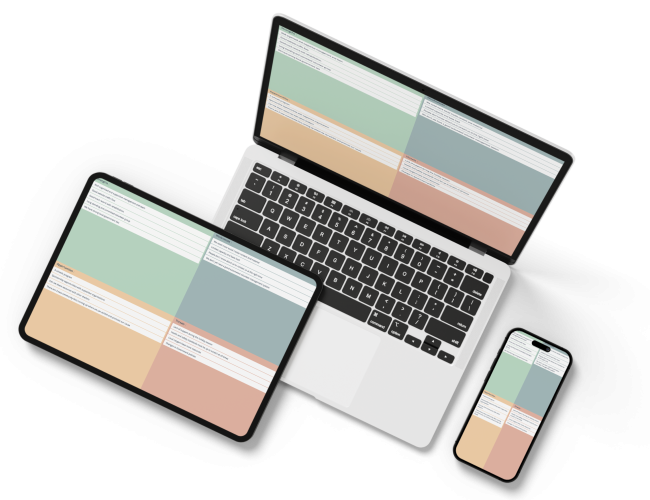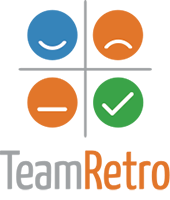
What is the Value Proposition Canvas?
The Value Proposition Canvas is a tool developed by Dr Alexander Osterwalder to ensure there is a fit between a product and market by exploring the relationship between a Customer’s needs and the value proposition of the organization.
This can be a new or an existing product or service, but aims to align what an organization delivers to reduce the pains and increase the gains for their target customer.
The Value Proposition Canvas has two building blocks – customer profile and an organisation’s value proposition.
In the Customer Profile block, we look at the following elements:
- Gains – the benefits which the customer expects and needs and the things which may increase likelihood of adopting a value proposition.
- Pains – the negative experiences, emotions and risks that the customer experiences in the process of getting the job done.
- Customer jobs – the functional, social and emotional tasks customers are trying to perform, problems they are trying to solve, and needs they wish to satisfy.
A customer profile is created for each customer segment, as each segment has distinct gains, pains and jobs.
In the Value Map block, we look at the value proposition that an organization offers through its products and/or services, including:
- Gain creators – how the product or service creates customer gains and how it offers added value to the customer.
- Pain relievers – a description of exactly how the product or service alleviates customer pains.
- Products and services – the products and services which create gain and relieve pain, and which underpin the creation of value for the customer.
Why Do a Value Proposition Analysis?
The Value Proposition Canvas can help any business or organization to:
- Define their customer profiles. By brainstorming and analyzing the Customer Profile block, companies can identify their customers’ major jobs-to-be-done, the pains they face when trying to accomplish their jobs-to-be-done, and the gains they perceive by getting their jobs done.
- Visualize the value of the organizations’ product or service create. Define the most important components of your offering, how you relieve pain and create gains for your identified and targeted customers.
- Achieve Product-Market fit. Adjust your Value Proposition based on the insights you gained from customer evidence and achieve Product-Market fit.
Related Templates
- Business Model Canvas
- Stakeholder Analysis
- Ansoff’s Matrix
- Feature Request Planning
- Lean Canvas
- Empathy Map
Tips for Effective Facilitation of Value Proposition Canvas
- We suggest starting with the right side – the Customer Profile – if you are interviewing your customer segments. But you could begin at the left and map out your value proposition as far as you understand that and use that to imagine your ideal customer.
- On the left side – the Value Proposition – we suggest starting with your product or service, but you could start with the pain relievers and gain creators and use those to brainstorm new products or services.
- Align both sides by ensuring that the value propsition addresses the most significant pains and gains from the customer profile.
- You may find that there are sections of the canvas you can’t complete and so you may need to pause and go do some research – client interviews, surveys, online research – to gather more information before continuing with the canvas.
References
- Osterwalder, A., Pigneur, Y., Bernarda, G., Smith, A. (2014) Value Proposition Design: How to Create Products and Services Customers Want, John Wiley & Sons.
Who Should Use a Value Proposition Canvas?
The Value Proposition Canvas is a great tool for marketing experts, product owners, and value creators and their teams, who work to develop products and services to a targeted audience. It is also valuable for any teams and organizations who are trying to understand how customers make decisions and what offers to create that they will find appealing.
When Should I Complete a Value Proposition Canvas?
- Understanding who your customers are, including what their lifestyles and real needs are to help create relevant products and services.
- Develop value propositions for your products and services for effective communications and marketing to your identified customers.
- Increasing the sales and profitability of your products and services.
- Reducing time wasted on developing ideas that customers may not be interested in.
- Improving or innovating new products or services.
The Right Way to use the Value Proposition Canvas
The value proposition template is essentially made up of 2 blocks with one being what the customer segment is and how we might best service their needs. You start by completing the various aspects of the canvas and then look for gaps and alignment to validate that what you are able or can deliver meets the needs of the customer.
While the canvas itself depicts the customer profile on the right and the natural inclination is for you to start with the goods and services of the business first, it is actually more important to firstly identify what your customer needs and expectations are. This way you are focussing on the needs of your customers and ensuring that the elements that you can control (what your product or services actually deliver) can be refined to ensure that there is alignment.
The next step is to then identify gaps and check that there is alignment between the 2 areas. This allows you to then create experiments, ask more questions or create action items that will help you move towards delighting the customer and growing your business. A really easy way is to have the team vote for the areas that need the most discussion.
Customer Profile
This section looks at what jobs or goals the specific customer has and what are their positive and negative states that they experience.
Start here.
Focus on just one segment at a time so that you do not confuse or have mixed messages in your planning process when completing the lean canvas.
Segments could be by age, social status, interest or psychographic.
By only having a single focus on the segment, it makes it easier to identify the highest priority jobs, pains and gains related to that segment. This helps you understand customer preferences, biases and thoughts.
The size of the segment can be refined if you are finding that it is too broad or too large and it starts to feel generic. For example, all people between 8 and 18 who use sunscreen is more specific than the Youth Market for sunscreen.
Value Proposition
This section is about what products and services are targeted at the segment and the key benefits provided when the customer buys from us.
Align here.
This is where you might list the actual or proposed services or goods that you might use to service the customer segment.
The goal here is not to simply list everything that you may do, but to highlight the key ones that are servicing that customer’s need.
For example, Sunscreen targeted at the ages 8 to 18 may be an aesthetic brand which has a shorter application time frame but higher SPF rating that matches their behaviour but might not include higher priced brands that have skin moisturising and anti-wrinkle qualities.
A well-suited message then connects the consumers mind to your brand or product if the value proposition is clear and meets their specific needs.
How to Complete a Value Proposition Canvas
Start a Value Proposition for a product or service by filling out the template and then where there are gaps. You can use the gaps as validation to run more experiments, ask more questions, try out new ideas. By understanding your customers’ preferences, biases and thoughts, you’ll find new ways to delight them and grow your business.

Brainstorm
Brainstorm ideas for each area of the Value Proposition canvas.

Group
Review responses, and collate ideas.

Vote
Rate the ideas according to likely impact on the organization.

Share
Share the outcomes of the session to relevant stakeholders.
Start brainstorming ideas by focussing on the right hand side of the template – the Customer Profile. GroupMap allows you to set the brainstorming style to be individual (each person only sees their own ideas first) or collaborative (everyone sees ideas as they are added.)
Start with the customer jobs and mention all the functional, emotional, and social jobs your customers do on a daily basis. Also include how they do that job, how they feel, and what social qualities come into play. And don’t forget to rate them according to their importance.
Ask a lot of whys, whats, and hows. They’ll lead you to uncover all the pains and gains behind the job.
Tips:
- Use your customer research, interviews and data to help you brainstorm this section.
- You might have more than one customer segment, if that is the case, it is recommended you do a customer profile for each segment on separate canvases.
- You can always break out larger groups into smaller groups and then rotate the canvases around in a single workspace to allow others to review and provide feedback around a particular segment.
Now you can move to the Value Proposition block and do a similar exercise.
Tips:
* You can use colour coding to indicate current product or service offerings vs new ones.
* Aim to identify just the top gain creators and pain relievers.
Online collaboration tools like GroupMap significantly reduce the amount of manual collation and different groups having to work to manually combine lists. It lets you comment on ideas, vote independently and provide a wider and deeper set of ideas with non-biased anonymous addition of ideas, all in real time.
Discuss and explore the canvas to look for items that may have been duplicated or are very similar in nature. You can select these to GROUP them so that they are in the same theme. You can add additional comments as needed.
Now ask people to look across the value proposition canvas to look for alignment. If they spot a gap or an issue, they can allocate dot votes to indicate areas that they would most like to discuss.
Alternatively, you can ask people to vote for areas where they see a need for change, or an opportunity for improvement.
In general, this may be 3 to 5 votes but you can change this as needed.
Votes are individual and independent to remove bias and GroupMap will automatically combine the votes so that you can immediately see where the hot spots for discussion are.
Use the results of the votes to go through each of the areas for change or improvement.
You can capture deep diver comments and further explore the area, or you can add an ACTION step in GroupMap so that you can assign specific actions to ideas.
The Value Proposition Canvas then becomes a live document that can be shared, iterated and developed over time.

Save Effort, Time and Money with GroupMap
GroupMap offers more than just an online digital whiteboard—it’s innovative platform is designed to enhance the quality of your team’s decisions. With features that prevent bias and make facilitation seamless, GroupMap ensures no single voice dominates and ensures productive, inclusive conversations.
Its intuitive interface is easy for anyone to use, and its scalable design supports small teams and large groups whether they are face to face or around the globe. Customisable templates and workflows keep discussions focused on objectives, helping you drive actionable outcomes each and every time.
Create your first map and invite people in to start sharing their thoughts NOW.
Experience the power of GroupMap with our FREE 14 day trial.
Your free trial gives you access to all of our features, no credit card required.
